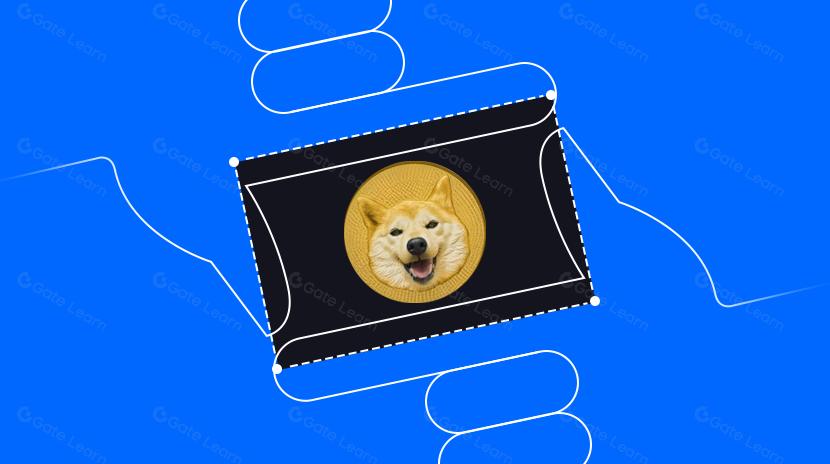No ecossistema Bittensor
Cripto sempre foi emocionante para mim. Sempre há coisas novas em algum lugar que posso aprender. Sou naturalmente uma pessoa curiosa, gosto de fazer muitas perguntas bobas, especialmente para pessoas técnicas, apenas para ter um vislumbre de suas visões e aprender com suas experiências valiosas.
IA não é exceção, na verdade as coisas estão avançando a toda velocidade com gigantes da tecnologia Web2 constantemente melhorando seus modelos, grandes aplicações capitalizando a IA, lançando casos de uso impulsionados pela IA
- @canvalançou ferramentas de IA para permitir que artistas e criadores não técnicos construam facilmente experiências interativas e aprimorem suas criações com IA
- @YouTubeintroduziu uma nova ferramenta de IA que permite aos criadores gerar música de fundo para vídeos
- Jogadores de transporte como Grab implantando IA agentica para apoiar comerciantes & parceiros motoristas
- Players de e-commerce como Lazada ajudando a introduzir ferramentas GenAI para ajudar vendedores com vendas, marketing e atendimento ao cliente
E a lista continua. Casos de uso práticos do mundo real que utilizam IA generativa e IA agente para melhorar fluxos de trabalho continuaram a ganhar adoção de empresas e usuários do varejo.
A coisa boa sobre essas tecnologias é que elas são facilmente acessíveis - você pode encontrar soluções gratuitas ou de baixo custo em todos os lugares. Os benefícios superam em muito os custos financeiros.
Mas o que as pessoas frequentemente ignoram são as compensações ocultas ao usar esses produtos de IA, como:
- Quem possui seus dados?
- Alguém pode pegar sua ideia e criar um produto concorrente?
- A plataforma é segura? Os seus dados podem vazar?
- Se a plataforma cair (como aconteceu com a AWS), isso poderia parar seu negócio? Os fundos dos clientes poderiam estar em risco?
- Você sempre pode acessar sua plataforma? É necessário verificar sua identidade? Se a plataforma fechar, você ainda possui seu produto ou negócio?
Muitas mais perguntas (falei sobre isso de forma mais extensiva no meu artigo anterior, se você ainda não o leu).
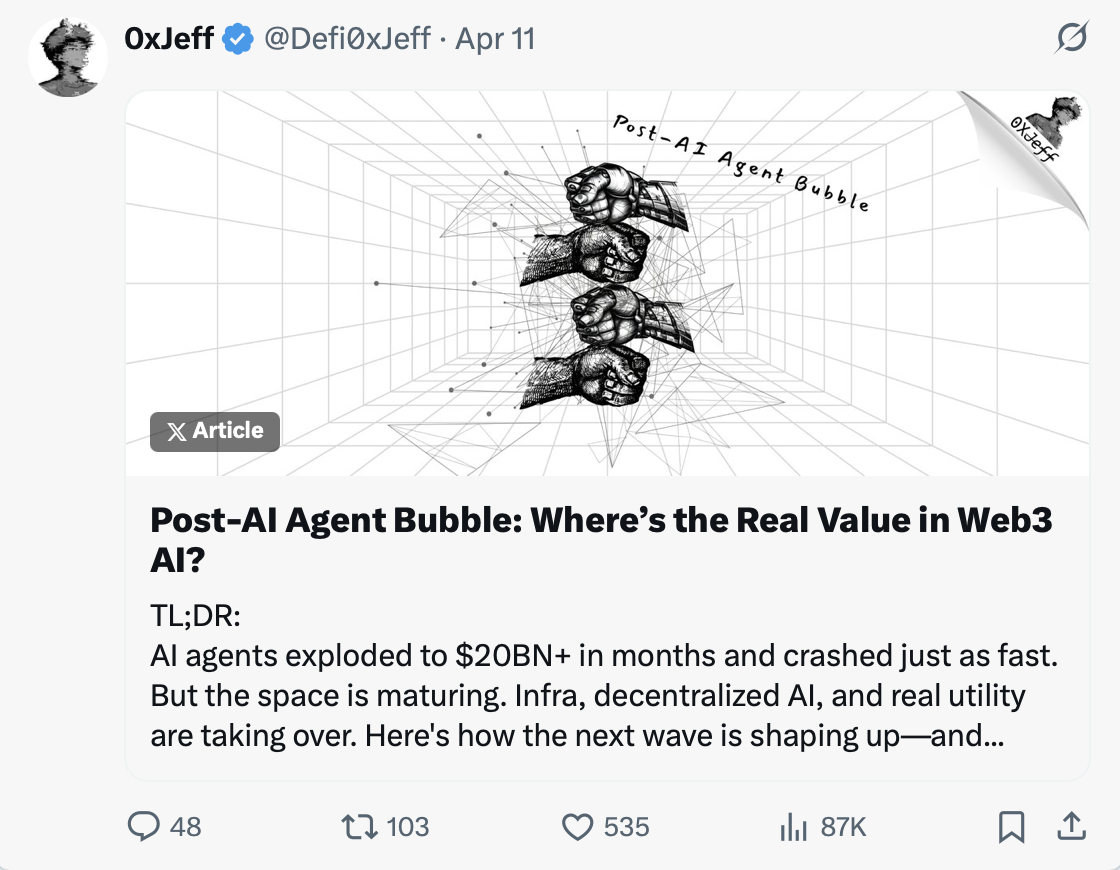
Jogadores centralizados têm o poder centralizado de tomar decisões que podem impactar drasticamente sua vida (inadvertidamente).
Você poderia argumentar que não importa - talvez você não use essas ferramentas muito, ou confie nessas empresas para agir no melhor interesse dos usuários. Tudo bem. Você pode até querer investir nessas startups de IA, já que estão aproveitando mercados endereçáveis massivos. Mas o problema é - você não pode. A menos que você esteja em @ycombinatorou uma grande empresa de capital de risco, você não tem acesso a esses acordos.
Por outro lado, no Web3 AI, existem muitos ecossistemas de IA investíveis com equipes que estão trabalhando para trazer produtos e serviços de IA descentralizados para os usuários. Um dos principais ecossistemas DeAI investíveis é @opentensor(Bittensor)
Bittensor: Darwinian AI
O Bittensor se enquadra na categoria de “IA Darwiniana”—a evolução da IA por meio da seleção natural. Pense nisso como Jogos Vorazes, mas para a IA, onde cada sub-rede tem seu próprio jogo da fome com “mineradores” como tributo (ou participantes). Eles competem entre si com seus próprios modelos & seus próprios dados em uma performance de uma tarefa específica. Apenas os modelos mais aptos (aqueles que se saem melhor) são recompensados. Modelos mais fracos são substituídos ou evoluem (por meio de treinamento, ajustes ou aprendizado com os outros). Com o tempo, isso leva a um ecossistema de IA mais robusto, diversificado e com alto desempenho.
O que é emocionante sobre o Bittensor em particular é o mecanismo de competição e incentivo que foi projetado para alinhar os incentivos entre diferentes partes interessadas. Eu destaquei os desafios que as equipes de agentes de IA da Web3 estão enfrentando no tweet abaixo...
tl;dr os tokens de agente atuais são bons para especuladores & bons para as equipes utilizarem como ferramenta para criar hype, mas é ruim para utilizar os tokens para adquirir & reter usuários, e também ruim porque não pode ser usado como incentivo para reter talentos (desenvolvedores, fundadores, etc.) especialmente quando o preço cai

Bittensor aborda isso usando um mecanismo orientado pelo mercado que aloca$TAOemissões para as sub-redes, incentivando e apoiando as equipes em sua trajetória. O mercado determina quais sub-redes recebem mais emissões ao apostar$TAOdentro dessas sub-redes. Uma vez apostado, o$TAOconverter em tokens da sub-rede Alpha. Quanto mais pessoas apostam, mais o preço do token alpha sobe, mais emissões você receberá (na forma de tokens alpha)
$TAOsegue cronograma de emissão muito semelhante ao$BTCcom oferta fixa de 21 milhões de tokens & ciclo de halving a cada 4 anos (todos os dias 7.200$TAOé emitido para sub-redes). O primeiro $TAOO halving está previsto para ocorrer por volta de 5 de janeiro de 2026, com o fornecimento circulante atingindo 10,5 milhões de tokens.
Por que isso é importante para os investidores
Não vamos entrar muito a fundo na tecnologia aqui, apenas quero compartilhar por que acho que Bittensor é um dos ecossistemas mais emocionantes do ponto de vista de negociação/investimento

Além da dinâmica compartilhada acima, quando você está negociando tokens de subrede alfa, parece que você está tanto negociando quanto cultivando ao mesmo tempo.
Isso ocorre porque toda vez que há uma valorização do preço dos tokens alpha, você experimenta a valorização do preço e, ao mesmo tempo, você experimenta $TAOemissões (na forma de tokens alfa).
Se a sub-rede se sair muito bem e subir no ranking, sua inicial$TAOo stack experimentará uma apreciação drástica de preço & um grande impulso nas emissões. Quanto mais cedo você estiver apostando o$TAOem sub-redes, quanto maior for o seu APY (porque o mercado ainda não percebeu, então há menos pessoas /$TAOstaked dentro de sub-redes)
dTAO vs Solidly

(h/t@DeSpreadTeam)
Solidamente ve(3,3) requer bloqueio a longo prazo & participação contínua. Perdas de emissões injustas (votando em pools de LP errados) são suportadas por todos os detentores (as emissões são despejadas, o preço de todos os detentores de tokens cai).
dTAO não requer bloqueio a longo prazo, então qualquer pessoa pode entrar e sair a qualquer momento, mas entrar (apostando em uma sub-rede) requer muita diligência / DYOR. Investir em uma sub-rede errada poderia levar a grandes perdas (uma vez que as pessoas podem sair facilmente, sem bloqueio ou qualquer coisa).
Mas Jeff, o FDV é tão alto! Como podemos investir em sub-redes com FDV superior a $500m?
FDV pode não ser a métrica certa para se observar aqui, já que as sub-redes ainda estão no início, então MC pode ser mais adequado aqui (se você estiver negociando a curto ou médio prazo).
Se você está preocupado com a inflação, vale a pena entender o 18%/41%/41% - essas são as emissões distribuídas para os proprietários de sub-redes, validadores e mineradores, respectivamente (na forma de tokens alfa). Como stakers / proprietários de tokens alfa, você está ganhando com os 41% da parte dos validadores, pois está delegando o seu $TAOpara eles quando você aposta.
Muitos proprietários de sub-redes continuam a manter seus tokens alpha recebidos das emissões para mostrar confiança, muitos têm diálogo ativo com validadores & miners para deixá-los otimistas e não despejar grande quantidade de seus tokens (esses estão disponíveis para você explorar no taostats a propósito)
Dando um zoom, um dos melhores gráficos que mostra bem as tendências dentro do ecossistema Bittensor são os gráficos abaixo

Fonte: taoapp
% TAO na Roots (sub-rede OG que gerencia o sistema de incentivos da Bittensor) continua caindo desde fevereiro, que é o mês em que o dTAO entra em operação, ENQUANTO % TAO nas Subnets continua a subir. Isso significa que os stakers/investidores estão assumindo mais riscos (apostar na rede Root renderá um APY conservador de algo em torno de 20-25% e não há valorização do token da sub-rede alpha na Root).
Essa tendência está alinhada com o ritmo em que as equipes de sub-redes estão lançando seus produtos. Desde o lançamento do dTAO, as equipes precisam construir publicamente, criar produtos que os usuários desejariam, iterar & encontrar PMF rapidamente, atrair usuários & gerar utilidade do mundo real com receita tangível rapidamente. Desde que entrei no ecossistema, pude sentir que o ritmo em que as equipes estão lançando é muito mais rápido do que em outros ecossistemas (devido à competição & à distribuição de incentivos)
Isso nos leva às sub-redes e seus casos de uso DeAI investíveis exclusivos
Principais Sub-redes & Casos de Uso
A equipe considerada a número 1 em enviar produtos com PMF, atende às pessoas do dia a dia, equipes que executam profissionalmente e mostram continuamente que constroem publicamente são@rayon_labs""> @rayon_labs — SN64 (Chutes), SN56 (Gradients), SN19 (Nineteen)
Chutes — oferece infraestrutura para implantar facilmente sua IA de forma serverless. O melhor estudo de caso para mostrar por que precisamos disso é a recente interrupção da AWS, se você depende de provedores centralizados, com a interrupção, seus aplicativos de IA podem falhar (levando a possível perda de fundos / explorações) devido a um único ponto de falha.

Gradients — Qualquer pessoa (sem conhecimento de codificação) pode treinar seus próprios modelos de IA (para casos de uso especializados, geração de imagens, LLMs personalizados) no Gradients. Recentemente lançou a versão 3 que é mais barata do que concorrentes

Nineteen — fornece uma plataforma para inferência de IA rápida, escalável e descentralizada (qualquer pessoa pode usar isso para casos de uso de geração de texto & imagem, pois é muito mais rápido que os concorrentes)

Além disso, Rayon está lançando a plataforma Squad AI agent, que é uma plataforma de construção de agentes de IA no estilo de nó de arrastar e soltar, fácil de usar e que tem despertado interesse na comunidade

Todas as 3 sub-redes combinadas possuem >1/3 das emissões totais de $TAO - Isso é um testemunho da capacidade da equipe de construir & entregar publicamente bons produtos que as pessoas desejariam (Rayon é aclamado como a equipe número um por muitos proprietários de sub-redes lol)
Gradients fez 13x em um mês (atualmente $32m MC)
Chutes 2.3x ($63m MC)
Dezenove 3x ($18m MC)
A tendência parece não parar tão cedo, especialmente com a taxa de adoção com Chutes (atualmente a sub-rede #1)
Além das sub-redes da Rayon Labs, existem muitas equipes interessantes - dobramento de proteínas, detecção de conteúdo deepfake / IA, modelos 3D, estratégias de negociação, LLM de role-play. Ainda não mergulhei fundo na toca do coelho para olhar tudo ainda, os que considero mais relacionados são as sub-redes sob "Sistemas Preditivos" (taopill) principalmente com
SN41 @sportstensor

Muitos de vocês podem conhecê-los de@AskBillyBets, Sportstensor é uma inteligência que ajuda a impulsionar as decisões de Billy (a equipe principal que lidera Billy é @ContangoDigitalque é um VC investindo em DeAI, bem como validador/minerador para sub-redes Bittensor)
O que é interessante sobre SN41 é o seu produto - Modelo Sportstensor. É uma competição entre mineradores que possuem os melhores modelos + conjuntos de dados para prever os resultados de partidas esportivas.
Exemplo: Na última liga da NBA, se você está apostando com a multidão (apostando nos favoritos da multidão), você experimentará cerca de 68% de precisão / taxa de vitória. Isso significa que todos que apostam nos favoritos da multidão ganham muito dinheiro? Não, na verdade eles perdem dinheiro. Se você apostar $100 em todos os favoritos da multidão, no final você acaba com um ROI negativo, perdendo cerca de $1.7k.
Embora os favoritos da multidão tendam a ter uma taxa de vitória melhor, eles vêm com melhores probabilidades, o que significa que você ganha menos dinheiro se estiver certo. As pessoas costumam se amontoar em seus favoritos, levando os azarões a terem chances bastante baixas de ganhar, o que significa que há muito dinheiro a ser capturado se você estiver apostando nos azarões certos.
É aqui que o modelo Sportstensor entra. Os mineiros executam seus próprios modelos de aprendizado de máquina (Monte Carlo, Random Forest, Regressão Linear, etc) com seus próprios dados (gratuitos ou proprietários) para obter os melhores resultados. O Sportstensor então calcula a média / mediana disso e usa como inteligência para identificar vantagens no mercado.
Uma probabilidade real no mercado é de 25:75. O modelo pode mostrar que há uma probabilidade de 45:55. Essa diferença de 15 é a vantagem. Se os modelos encontrarem muitas vantagens desse tipo, você não precisa de uma grande taxa de vitória para começar a acumular ROI positivo a longo prazo.

Confira o relatório completo de negociação deles aqui (se você quiser cavar mais fundo):

Este é o resultado do modelo deles compartilhado em seu último relatório. Números bastante impressionantes. A equipe também tem mantido um fundo de apostas todos os meses, começando com $10k como reserva, usando os lucros para continuar apostando com sua inteligência. No final do mês, eles usarão o lucro para recomprar seu token alfa. A equipe obteve cerca de $18k de lucro em março.

Dependendo de como você está usando a inteligência, você pode obter resultados muito diferentes, por exemplo, a inteligência produz 35:65 e as probabilidades reais no mercado poderiam ser 40:60. Uma pessoa pode apostar nisso, você pode não apostar porque a diferença é pequena e não há margem suficiente. O que o Billy faz com a inteligência difere do que o Sportstensor faz com sua inteligência. (Ninguém sabe qual é a melhor maneira de obter consistentemente ROI positivo até agora, pois está muito no início)
A Sportstensor planeja monetizar ainda mais sua inteligência criando um painel onde os usuários podem compreender facilmente as informações e tomar decisões de apostas com base nelas.
Eu pessoalmente gosto desta equipe porque há muitas maneiras de seguir com seu produto. Já vimos o impacto disso com base em como Billy foi capaz de conquistar a atenção e animar a multidão esportiva para apostar ao lado de Billy. Como a equipe cobre muitos esportes, há muitas maneiras pelas quais os agentes podem mudar as formas como as pessoas se envolvem, interagem e apostam.
SN44 @webuildscore

Pontuação usada para construir algo semelhante ao Sportstensor, mas mudou para Visão Computacional após perceber que há muito mais valor que vem com a capacidade de prever o que está por vir.
Para entender isso, é necessário ter visão computacional para analisar o que está acontecendo na tela, para que a IA entenda os objetos na tela, os localize e anote os dados, depois tire conclusões sobre os dados com diferentes algoritmos (conclusões como a probabilidade de um jogador fazer uma determinada jogada), e transformar tudo isso em uma pontuação universal que pode ser usada para melhorar o desempenho dos jogadores (bem como procurar talentos precocemente)
Os mineradores competem para anotar os objetos (este é o primeiro objetivo principal para os mineradores). A pontuação utiliza seu algoritmo interno para tirar conclusões (por enquanto).
Quando você pontua um jogador (semelhante a definir um Elo no xadrez ou no LoL, mas mais granular e dinâmico.. muda dinamicamente em cada jogo com base nas decisões dos jogadores e em seu impacto), você pode fazer muitas coisas como donos de clubes, pode encontrar talentos muito jovens. Se você tiver imagens de um jogo de crianças, será a mesma abordagem para um jogo profissional. É quantificar todo o mundo do futebol com a mesma abordagem.
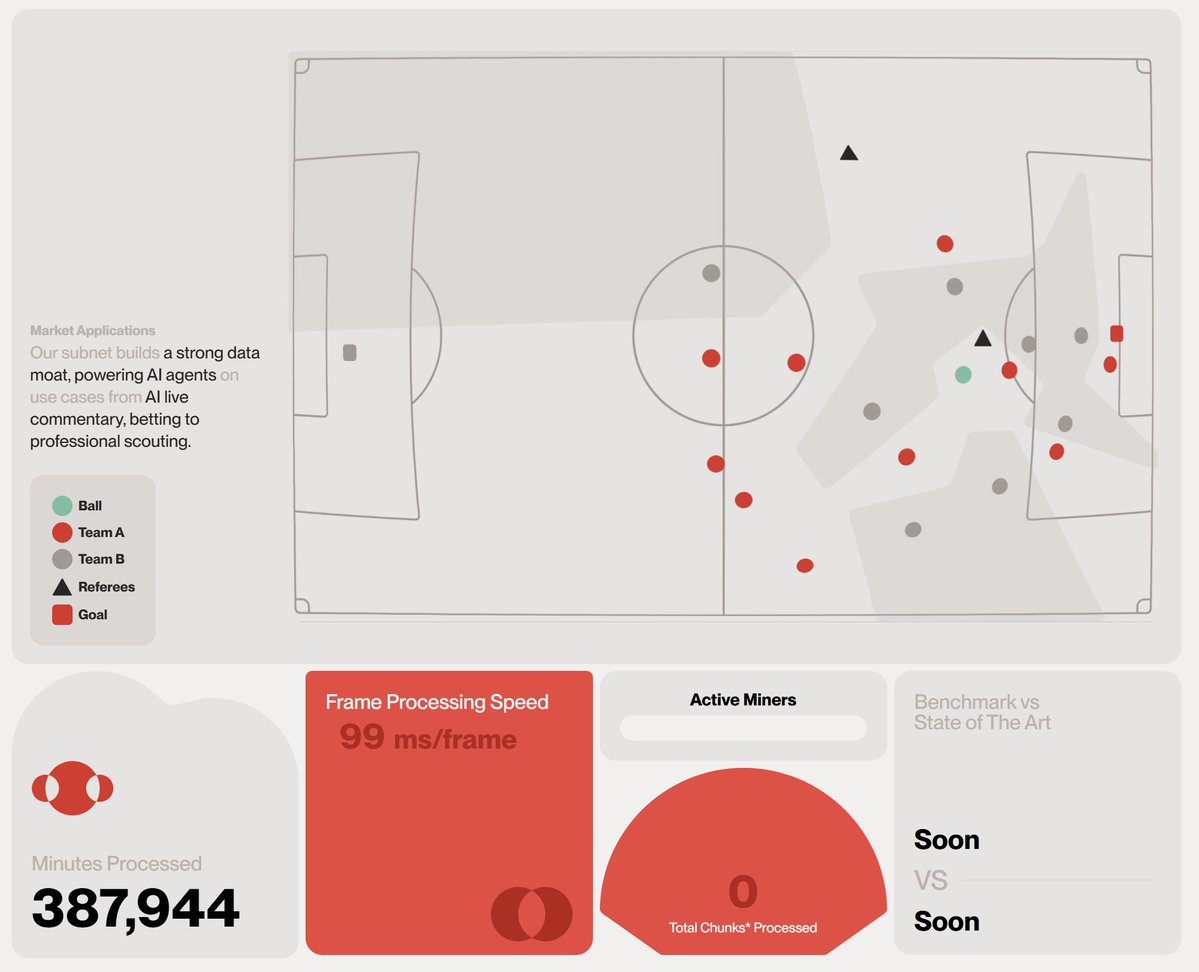
A partir dos dados proprietários, o Score pode monetizar a pontuação e as insights para corretores de dados, proprietários de clubes, empresas de dados esportivos e empresas de apostas.
Para aplicações de consumo, Score está fazendo coisas diferentes
@thedkingdao, um fundo de hedge esportivo DAO, um cliente da Score com modelos de apostas que consomem dados da Score & os transformam em execução de apostas acionáveis. Terminal v2 com lançamento amanhã (os usuários terão acesso ao modelo completo com diferentes modelos de assinatura para análise de partidas, fazer perguntas avançadas sobre gestão de banca, ou seja, o melhor companheiro de apostas, usar o agente para elaborar sua própria estratégia). Produto Vault onde os usuários podem inserir TVL e o agente fará apostas automáticas oferecendo rendimentos das apostas provavelmente no próximo mês (ou antes do verão).
Em breve, as pessoas poderão fazer upload de vídeos em uma plataforma de autoatendimento da Score para que os vídeos sejam anotados pelos mineradores. Geralmente, as filmagens de jogos de futebol costumam levar horas, os mineradores levam de 10 a 12 minutos para anotar um jogo de 90 minutos, o que é significativamente mais rápido do que em qualquer outro lugar. Os usuários podem então pegar os dados anotados e usá-los em seus modelos para seus próprios casos de uso.
Pessoalmente, gosto do Score porque isso pode ser aplicado a tudo fora do esporte, por exemplo, carros autônomos, robótica, etc. Em um mundo onde dados ruins estão em toda parte, dados proprietários de alta qualidade são muito procurados.
SN18 @zeussubnet

Esta é uma nova sub-rede que recentemente ganhou muita tração. Ainda não tive a chance de falar com a equipe, mas o produto é bastante interessante.
Zeus é uma sub-rede de previsão do clima/tempo baseada em ML que é projetada para superar os modelos tradicionais ao fornecer previsões mais rápidas e precisas.
Esse tipo de inteligência é altamente procurado por fundos de hedge, uma vez que prever com precisão o tempo pode levar a uma melhor previsão dos preços das commodities (os fundos de hedge pagariam milhões para acessar a inteligência, já que podem ganhar centenas de milhões se acertarem as negociações de commodities)
A sub-rede Zeus é bastante nova, uma vez que adquiriram recentemente a sub-rede 18. O token alpha subiu recentemente 210% nos últimos 7 dias
Outras sub-redes nas quais estou interessado, mas ainda não explorei mais a fundo
- @404gen_SN17 — infraestrutura para ativos 3D gerados por IA. Crie modelos 3D para jogos, personagens de IA, vtuber, etc. Integração recente c/@unitypode permitir a geração contínua de modelos 3D, alterando o fluxo de trabalho criativo para 1,2 milhões de usuários ativos mensais da Unity
-@metanova_labsSN68 — Sub-rede de descoberta de medicamentos DeSci que transforma a descoberta de medicamentos em uma competição colaborativa e de alta velocidade, abordando desafios tradicionais como custo e tempo (o processo tradicional leva mais de uma década e pode custar bilhões)
E muitos mais que compartilharei mais tarde, assim que tiver a chance de aprofundar. Estou começando com os que são mais fáceis para mim entender (já que não sou uma pessoa técnica)
Finalizando as Coisas
Tentei o meu melhor para não ficar muito técnico aqui. Há um monte de bons recursos sobre a explicação técnica de todo o dTAO, emissões, distribuição de incentivos, todos os stakeholders, blá blá blá.
Com base no que aprendi durante a temporada de agentes (24 de outubro - agora) é manter-se bastante ágil. Tenho sido um detentor de bolsa para projetos demais e acho que o dTAO oferece uma mecânica bastante boa para se manter ágil e girar entre diferentes startups DeAI investíveis.
Atualmente, ainda não há muitos participantes, portanto, os usuários podem experimentar um APY de 80% a 150%+ além da valorização do preço das sub-redes. Essa dinâmica provavelmente mudará nos próximos 6 meses, quando mais pessoas aderirem e a eco TAO tiver melhores pontes, carteiras e infraestrutura de negociação.
Por enquanto, sugiro que você aproveite a temporada PvE no TAO e aprenda mais sobre a tecnologia DeAI legal comigo :D
Obrigado por conferir minha primeira peça. Vejo vocês novamente em breve no próximo!
0xJeff
Nota pessoal: Muito obrigado por ler! Se você está no Crypto AI e quer se conectar, mande uma mensagem direta!
Também, obrigado @mxmsbt, @luciancxyz, @gylestensora, @contangojosh,@mikecontango, @JosephJacks_,@Old_Samster,@bloomberg_sethpara me ajudar a me atualizar sobre tudo Bittensor.
Estarei entrando em contato e conectando com mais proprietários de sub-redes na próxima semana e aprendendo sobre o que todos estão trabalhando.
Aviso legal:
Este artigo é reproduzido a partir de [X]. Todos os direitos autorais pertencem ao autor original [@Defi0xJeff]. Se houver objeções a essa reimpressão, entre em contato com o Gate Learnequipe, e eles resolverão rapidamente.
Responsabilidade Legal: As opiniões expressas neste artigo são exclusivamente do autor e não constituem nenhum conselho de investimento.
As traduções do artigo para outros idiomas são feitas pela equipe Gate Learn. Salvo indicação em contrário, copiar, distribuir ou plagiar os artigos traduzidos é proibido.
Artigos Relacionados
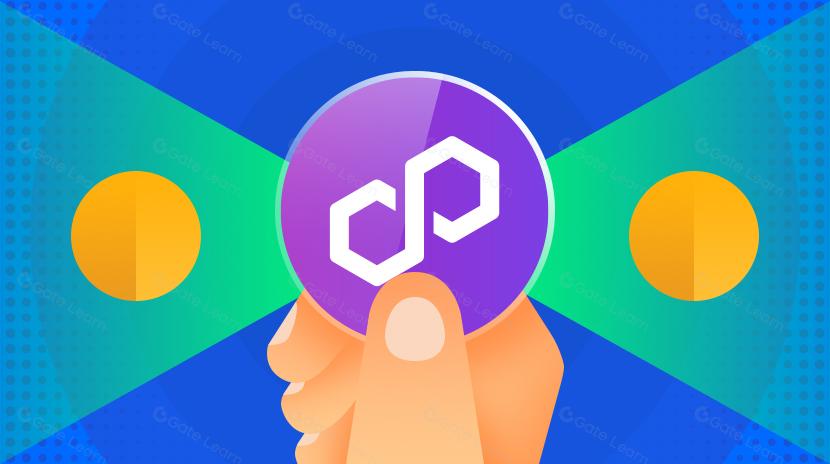
O que é o PolygonScan e como você pode usá-lo? (Atualização 2025)

O que é Bitcoin?

O que é Tronscan e como você pode usá-lo em 2025?
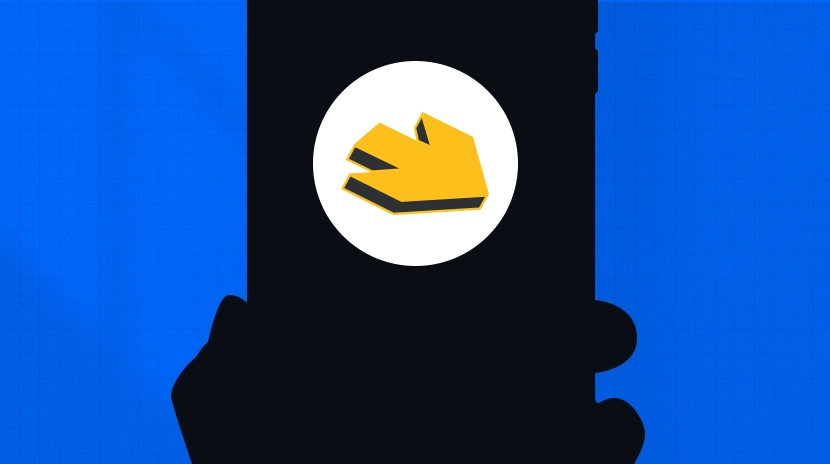
O que é a Carteira HOT no Telegram?
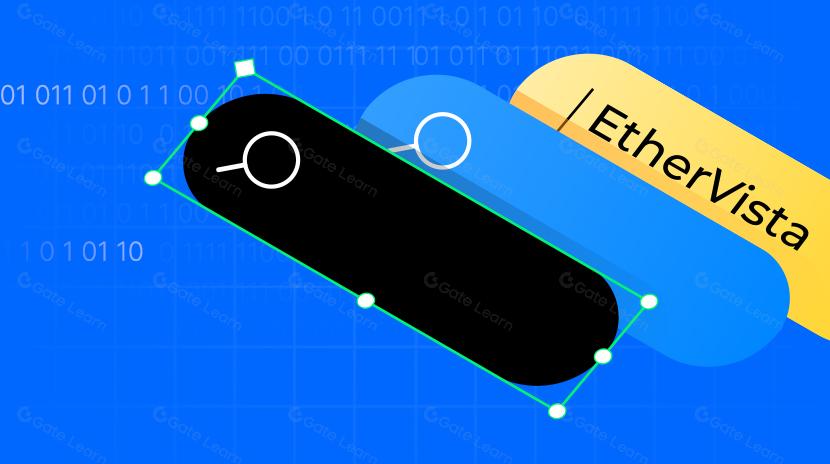
O que é EtherVista, o autoproclamado "Novo Padrão para DEX"?
